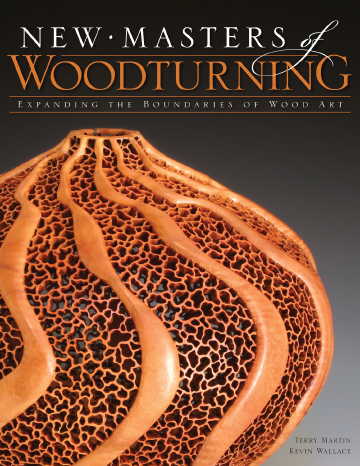

New Masters of Woodturning
By Terry Martin and Kevin
Wallace
Reviewed by Mike Bloomquist
 At first I wasn't
sure what
to tell you about this one. It had been in the bookstores where
Idefinitely took a
gander at it, because I'm a very amateur woodturner. It was
basically a
collection of artists work, their profiles, and ocassionally their
workspaces. First impression was a gallery book with some very
fine
photography, but it nagged at me because the contents didn't quite fit
the
title. I was impressed, but put it back.
At first I wasn't
sure what
to tell you about this one. It had been in the bookstores where
Idefinitely took a
gander at it, because I'm a very amateur woodturner. It was
basically a
collection of artists work, their profiles, and ocassionally their
workspaces. First impression was a gallery book with some very
fine
photography, but it nagged at me because the contents didn't quite fit
the
title. I was impressed, but put it back.
Good thing I did, because a
copy arrived in the mail not long after and I said
"Huh? Why did Matt send me this to review? " This book is about woodturning, not woodcarving.
Looking through it again, carefully, gave me this nagging thought again
that it wasn't really a
book about woodturning on the "cutting" edge, but something else.
After several sessions of reading and scanning through it I came to the
conclusion that it's mis-titled, but I have no idea what else they
could have
called it. Ironically, the subtitle "Expanding the Boundaries of
Wood Art" describes it better.
There seems to be
three
"flavors" of artists in this book. There are a few folks in here
that are using advanced turning techniques and
equipment, but nothing revolutionary. Their work is impressive in
how it
combines these advanced techniques into a beautiful personal style, and
in that
respect they earn the title "New Masters". However, most of the
rest of the book is made up of truly impressive artists that simply use
lathes
in the same way the majority of woodcarvers would use a band saw,
as a
means to rough out the wood to a primary form. They produce
a
beautiful vase shaped "blank", then carve on it or carve into it and
conjure a shape of beauty at a still higher level. The majority
of the
masterwork is accomplished with their woodcarving skills. Going
back to
the lathe/band saw similarity, there is a contrast there as well.
In most cases, a carver does not want the original band sawed block to
show
through in the final work. In the pieces I enjoyed the most, the
original "turned" geometric
shape enhances the final carving a great deal. The third
"flavor"? There are a couple of artists
here with pieces that are enjoyable to see, but you have a hard
time recognizing
where they used a lathe. Camouflaging their lathe work may seem
like a
clever ruse, but it makes you wonder where the advantage was to using
the
tool in the first place. So I guess my final impression of this
book
answers the question "Why am I reviewing a woodturning book for a
woodcarving e-zine?" Because it has many very, very inspirational
examples of woodcarving in here being done on turned objects
to a good advantage.
What's inside:
Contents
I hope we didn't come off as
biased against wood turners in this review. Truthfully it's a
very
enjoyable (and addictive) wood art all by itself, and if you ever get a
chance
to watch it demonstrated, grab the opportunity. Better yet, find
someone who
teaches and have a "turn" at it yourself. No nit-picks this
time, just a small caution. There is little-to-no instruction in
this
book, but a very fine collection of wood art in a gallery/biography
format.
Something to get your creative juices flowing.
Well fellow woodcarvers, 'till next time keep them edges keen, the
chips piled
high, and we'll see ya again as the WOM turns...
Keep on Carvin'
-Mike Bloomquist->
 Mike
Bloomquist is a carver
and carving teacher, and a regular contributor to WOM.
Mike
Bloomquist is a carver
and carving teacher, and a regular contributor to WOM.
You may visit Mike's web site, Wooden Dreams Woodcarving HERE or email him at m.bloomquistATverizonDOTnet.